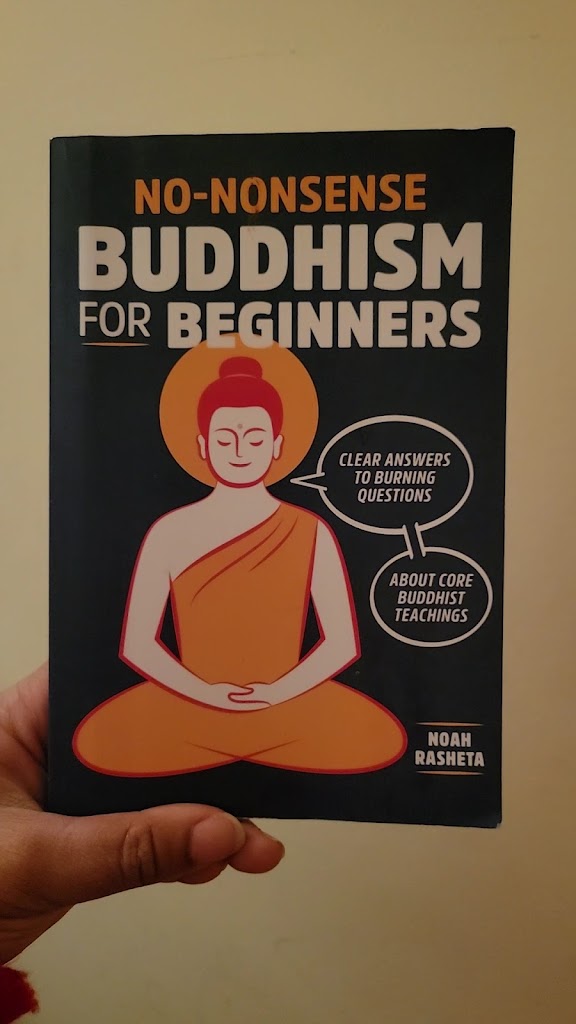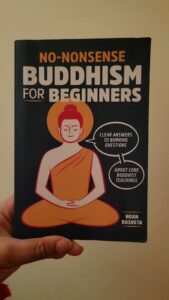Reed Reads: No-Nonsense Guide to Buddhism
In one of my podcast episodes, I discussed the reading challenge my friend Tikima issued to my friend group. I mentioned – and even quoted – the book, No-Nonsense Buddhism for Beginners by Noah Rasheta (affiliate link).
I read a lot of fiction as a kid – that was my jam. But nowadays, I prefer to read nonfiction. Many of the books I’ve read in the past few years have been philosophy and self-help-type books, but I also really like to read autobiographies of interesting people, and I’ve been getting into reading history a bit more. It’s a lot less boring when you’re not forced to do it through school!
The Structure of the Book
The author, Noah Rasheta, divided the book into four parts:
- The Buddha
- Core Concepts
- Core Teachings
- Core Practices
Sprinkled throughout, there are real-life examples – I would call them teaching moments – which the author calls “everyday Buddhism moments.” There are quotes from the Buddha and a short bit of history. Again, this book is light reading but is thought-provoking enough that you’ll want to go and conduct your own research afterward.
There are also some great resources at the back of the book and some references. I particularly appreciated the resources because I found that there are a few books on the list that I actually had on my bookshelves and are on my reading list. It was great to how they are related to each other.
I enjoyed this book, and while I recognize that the purpose of the book was to help gain a surface-level understanding of Buddhism, I did wish that the author had gone a little deeper on certain topics. However, this book served as an excellent explainer/introduction to Buddhism.
From the online reviews, a lot of people felt like there needed to be more historical context and maybe cultural context, but I think for somebody who’s just exploring Buddhist principles it’s a good starting point and note it’s all about self-exploration anyway. After reading this book, I highly recommend diving deeper into the resources and conducting your own research online.
My Key Takeaway from the Book
As for the content, what resonated with me was the topics of mantras and chanting. To ring in the new year, I attended a silent yoga retreat. There was a lot of chanting, which was a new experience for me, but I enjoyed it. I came to find more comfort in it throughout the retreat than when I first arrived.
Here’s what the book had to say:
The first time I heard Buddhist chanting, I thought it was a bit strange. It seemed to me like some mysterious form of worship, but later, when I talked about it with a friend of mine, he pointed out that we’re already repeating things to ourselves all the time. Habitual thoughts, like, “I’m such an idiot,”or, “I’m so much better than everyone else.” are sorts of mantras that we repeat to ourselves over and over, and they do have an effect over time on how we view ourselves and others.
Page 121, Core Practices, “Youre Already Chanting”
This passage got me thinking about the things that I repeat to myself, what are the words that I use every day, and what kind of self-talk am I normalizing? Would I talk to my friends and family like that? If the answer is no, why would I talk to myself like that?
I want to go back a little bit to discuss the structure of the book. As I mentioned, there are four different sections of the book. There’s a big question at the top of the page, and then there’s the answer underneath – or a way to arrive at an answer. For example, there’s one that says, “I’ve seen statues and paintings of a fat Happy Buddha. Is that what the Buddha looked like?” There’s an answer to that and I’m not going to tell you (read the book or look it up 👅).
My Rating
Out of 5 stars, what would I give this book? I’d probably give it a 3.5 or 4 stars.
It was an easy read that can probably finish on a flight on a long flight. I read it over the course of just a few days when I had short breaks during my yoga retreat, and it was really great timing to read it during such a retreat.
Why wouldn’t I give it 5 stars? It was an easy read and answered a lot of questions, but it also created more questions that I think than it answered. Most of the questions that are addressed are questions that most people would have about something that’s new to them such as Buddhism. Nonetheless, I still felt like some information was lacking. There were also some typos in the book, which at times I found distracting.
I’m curious what kinds of books you’re reading, and what kind of books you generally read. I have 23 books to read this year, and I’m looking for some recommendations! Nonfiction is my favorite right now, but I’ll take anything you’ve got for me!

